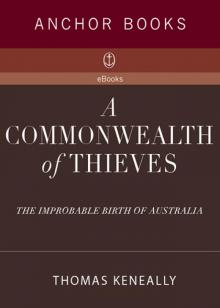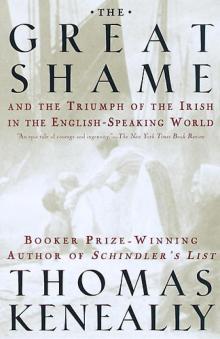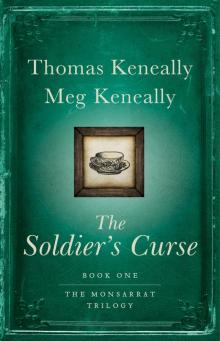- Home
- Thomas Keneally
A Commonwealth of Thieves
A Commonwealth of Thieves Read online
Contents
Title Page
Epigraph
Author's Note
Map
Book One
Chapter One
Chapter Two
Chapter Three
Chapter Four
Chapter Five
Chapter Six
Chapter Seven
Chapter Eight
Chapter Nine
Chapter Ten
Chapter Eleven
Chapter Twelve
Chapter Thirteen
Chapter Fourteen
Book Two
Chapter Fifteen
Chapter Sixteen
Chapter Seventeen
Chapter Eighteen
Chapter Nineteen
Chapter Twenty
Chapter Twenty-One
Chapter Twenty-Two
Chapter Twenty-Three
Chapter Twenty-Four
Chapter Twenty-Five
Chapter Twenty-Six
Chapter Twenty-Seven
Chapter Twenty-Eight
Chapter Twenty-Nine
Epilogue
Notes
Bibliography
Weights and Measures
About the Author
Also by Thomas Keneally
Copyright
Eora people asked the question,
Waube-rong orab,
Where is a better country?
This thief colony might hereafter become a great empire,
whose nobles will probably, like the nobles of Rome,
boast of their blood.
The Morning Post, LONDON,
1 NOVEMBER 1786
author’s note
I have taken the liberty in quotations from historic sources to standardise spelling, and in cases of misspellings left intact, to avoid the use of the mannerism “[sic].” Any insertions I have made for the sake of clarifying the intentions of the original writers are signalled by square brackets.
All Aboriginal personal and place-names have variations with which generally I have avoided burdening the text, though some of the variant spellings can be found in the notes.
As the text makes frequent use of imperial measurement, a conversion table to metric has been provided at the end of the book.
T.K.
one
IF, IN THE NEW YEAR of 1788, the eye of God had strayed from the main games of Europe, the Americas, Asia, and Africa, and idled over the huge vacancy of sea to the south-east of Africa, it would have been surprised in this empty zone to see not one, but all of eleven ships being driven east on the screaming band of westerlies. This was many times more than the number that had ever been seen here, in a sea so huge and vacant that in today's conventional atlases no one map represents it. The people on the eleven ships were lost to the world. They had celebrated their New Year at 44 degrees South latitude with “hard salt beef and a few musty pancakes.” Their passage was in waters turbulent with gales, roiling from an awful collision between melted ice from the Antarctic coast and warm currents from the Indian Ocean behind them, and the Pacific ahead. High and irregular seas broke over the decks continuously, knocking the cattle in their pens off their legs. The travellers knew they were past the rocks of sub-Antarctic Kerguelen Island and were reaching for the dangerous southern capes of Van Diemen's Land, which they intended to round on their way to their destination.
What would have intrigued the divine eye was the number of vessels—though they travelled in two sections, each division separated from the other by a few hundred miles. So far in the history of Europe, only six ships had come into this area named the Southern Ocean, which lay between the uncharted south coast of New Holland (later to be known as Australia) and Antarctica's massive ice pack. In 1642, a Dutchman, Abel Tasman, a vigorous captain of the Dutch East India Company, had crossed this stretch to discover the island he would name Van Diemen's Land after his Viceroy in Batavia (now Jakarta), but which would in the end be named Tasmania to honour him.
His ships, a high-sterned, long-bowed yacht named Heemskerck and a round-sterned vessel of the variety called a flute, the Zeehaean, were of such minuscule tonnage as to be overshadowed by HMS Resolution and HMS Adventure's roughly 400 ton each. These last two, still tiny vessels by modern standards, less than one-third a football field in length, came through the Southern Ocean in 1774 under the overall command of the Yorkshireman James Cook. The Resolution travelled well to the south near the Antarctic ice mass, and rendezvoused with Adventure at the islands Tasman had named New Zealand. Then in 1776, the Resolution and the HMS Discovery, again under Cook, could have been seen in these waters. And that was all.
What were these eleven ships that in 1788 followed the path of Cook and Tasman to the southern capes of Van Diemen's Land? One might expect them to be full of Georgian conquistadors, or a task force of scientists to suit the enlightened age. If not that, then they must have carried robust dissenters from the political or religious establishment of their day.
The startling fact was they carried prisoners, and the guardians of prisoners. They were the degraded of Britain's overstretched penal system, and the obscure guardians of the degraded. Any concepts of commerce and science on these ships were secondary to the ordained penal purpose. Few aboard had commercial capacities, though a number of the gentlemen were part-time scientists. Their destination was to be not a home of the chosen, or even a chosen home, but a place imposed by authority and devised specifically with its remoteness in mind. The chief order of business for all of them, prisoners and guardians, was to apply themselves to a unique penal experiment.
The merchant ships of the fleet were to return to Britain after discharging their felons, picking up cargoes of cotton and tea in China and India on the return journey. But because this outward cargo was debased, some in Britain expected never to hear again from the fleet's passengers. It was believed they would become a cannibal kingdom on the coast they were bound for, and—one way or another—devour each other.
THE IDEA OF EXPELLING CONVICTS to distant places was not new. It had occurred to European powers from the fifteenth century onwards, once they began acquiring huge and distant spaces in the Americas, Africa, and Asia. As a policy, it could solve many problems at the one time, including the problem which in modern days would be designated NIMBY, Not In My Backyard. But the chief difference of opinion soon emerged. As early as 1584, Hakluyt's Discourse for Western Planting proposed that “sturdy vagabonds” should be sent away to the colonies so that “the fry of the wandering beggars of England that grow up idly and burden us to this realm may there be unladen, better bred up, and may people waste countries.” Francis Bacon, however, debated the wisdom of unloading miscreants on far-off dominions in his essay Of Plantations. “It is a shameful and unblessed thing, to take the scum of people, and wicked and condemned men, to be the people with whom you plant.”
In reality, Hakluyt would win the debate with Bacon. It was “the scum of people, and wicked and condemned men”—and women—who made up the cargo of the criminal transports found in the Southern Ocean in the New Year of 1788. It would not have consoled the condemned on those wind-tossed mornings as they stirred and complained in their 18 inches of space on the convict decks that, uniquely placed as they were, they were also part of a long European tradition of transporting the unfortunate and the fallen, beginning with Cromwell's transportation of many Irish peasants, sent as labour to the plantations of the West Indies, and progressing to the 1656 order of the Council of State that lewd and dangerous persons should be hunted down “for transp
orting them to the English plantations in America.”
In Britain, colonial penal arrangements were recourses governments thought of regularly. When prisoners were landed in the American colonies throughout the seventeenth and eighteenth centuries, settlers would buy a prisoner's labour—generally for seven years—at the auction block. The master took over the prisoner and troubled the authorities only in the case of escape or major unruliness. Between 1650 and 1775, some tens of thousands of prisoners were sent on these terms to America, perhaps as many as 120,000. Sometimes vagrants and the poor— “idle person lurking in parts of London”—would voluntarily let themselves be transported and sold with the criminals.
The trade in convict or indentured servants was attractive to the British government because, unlike the prison system, it cost them little. Merchants would transport them cheaply, sometimes for nothing, in return for what could be earned through selling the convicts' labour. In fact, merchants often found this trade in white servants cheaper than that in African slaves. Between 1729 and 1745 the two chief contractors in London sent to America an average of 280 prisoners a year each, up towards 600 a year in total. Based on auction prices in Baltimore between 1767 and 1775, a convict's labour cost between £10 and £25, and it was possible for an affluent convict to bid for himself and do his time as, effectively, a free agent. But very few transported convicts could afford to buy their own labour or return home from Virginia, Maryland, or Georgia, even if they survived the “seasoning period,” the first few years of malaria and other diseases which killed two out of five inhabitants of Virginia; and so the convict engaged in field labour was likely to find an early grave in American soil.
In extolling the benefits of transportation for the home nation, the British government gave little attention to the impact it had on the region that received the felons. One North American colonist was left to complain that “America has been made the very common sewer and dung yard to Britain.” “Very surprising, one would think,” wrote another American colonist in 1756, “that thieves, burglars, pickpockets and cutpurses, and a herd of the most flagitious banditti upon earth, should be sent as agreeable companions to us!” Thomas Jefferson, the third president of the United States, was faced with the same problem of post-colonial denial as later generations of Australians, and wrote unreliably that he did not think the entire number of convicts sent out to the American colonies would amount to 2,000, and “being principally men eaten up with disease, they married seldom and propagated little.”
THE MEN AND WOMEN SURVIVING on flapjacks and desiccated salted beef and pease—a porridge of compacted peas—in the great Southern Ocean convict flotilla in 1788 owed their location to the pressure on British prison populations. A new Transportation Act in 1780 had sought to make transportation more obligatory than it had been up to that point.
The offences for which a prisoner could be transported under the accumulated Transportation Acts of Britain made up an exotic catalogue. Quakers could be transported for denying any oath to be lawful, or assembling themselves together under pretence of joining in religious worship. Notorious thieves and takers of spoil in the borderlands of Northumberland and Cumberland, commonly called “moss-troopers” and “reivers,” were also subject to transportation; similarly, persons found guilty of stealing cloth from the rack, or embezzling His Majesty's stores to the value of twenty shillings; persons convicted of wilfully burning ricks of corn, hay, or barns in the nighttime (crimes generally associated with peasant protest against a landlord); persons convicted of larceny and other offences; persons imprisoned for exporting wool and not paying the excise on it; persons convicted of entering into any park and killing or wounding any deer without the consent of the owner; persons convicted of perjury and forgery; persons convicted of assaulting others with offensive weapons with the design to rob; vagrants or vagabonds escaping from a house of correction or from service in the army or navy; persons convicted of stealing any linen laid to be printed or bleached; ministers of the Episcopal Church of Scotland suspected of support for Bonnie Prince Charlie, exercising their functions in Scotland without having registered their letters of orders, taken all oaths, and prayed for His Majesty and the Royal Family by name; persons returning from transportation without licence; persons convicted of entering mines of black-lead with intent to steal; persons convicted of assaulting any magistrate or officer engaged in the salvage of ships or goods from wrecks; persons convicted of stealing fish in any water within a park, paddock, orchard, or yard. Besides the penalty of transportation, between 1660 and 1819, 187 statutes providing for mandatory capital punishment were passed on the same principles to add to the nearly fifty already in existence. This was all a disordered and unfocused attempt to produce what would be called in modern times “truth in sentencing.”
One sees in the long list a heavy emphasis on the sanctity of two institutions: property and the Crown in the guise of the Royal House of Hanover. The Irish and certain Scots were resistant to the Crown as it existed; and as for property matters, William Blackstone, author of Commentaries on the Laws of England, thought with his eminent friends Dr. Samuel Johnson and Oliver Goldsmith that “theft should not be punished with death,” but Parliament went on churning out statutes which did just that. The very lack of a British police force meant that legislators needed to impress the people with the terror of the law.
In theory, frequent public executions should have cut down on crowding in gaols. But even the lawmakers, members of the Commons, might mercifully take up the special cause of a prisoner, and the way the statutes were applied by magistrates, judges, and juries was inconsistent and ill-coordinated, depending in a given courtroom and amongst the jury on feelings either of compassion for the accused—for example, terms commonly used to explain leniency included the prisoner being “too young,” or “a poor unfortunate girl”—or else of sometimes gratuitous outrage.
Some of the women prisoners and many of the males on the great Southern Ocean fleet owed their presence on the prison decks to their youth or good looks. Many of them had had their sentences of death commuted, and in other cases juries had adjusted the official value of goods stolen to bring it below the level prescribed for hanging. Not that the prisoners, taking the air on the squally deck while their blankets dried out, called down blessings on the British criminal justice system. The accused prisoner generally came in front of the courts at quarter sessions or assizes without the judge or jury enquiring too closely into whether a confession had been beaten out of him, and generally without legal counsel. Curiously, a first offender in theft cases was entitled, by a legal technicality, to claim the grotesque medieval “benefit of clergy.” The imputation was that the court could not prove the prisoner had not received divine orders, or the early rites prior to ordination which would make him a member of the clergy, and thus subject to special consideration by the civil courts.
Once that was out of the way, the trial proceeded more briskly than in modern times—the Georgian version of a day in court was a quarter of an hour. Major cases all ended with acquittal, transportation, or the death penalty, also called the “hearty choke with caper sauce,” “nothing more than a wry face and a watered patch of breeches,” and “dancing the Paddington frisk.” About one in eight of those committed for trial was sentenced to death, but (based on figures concentrated between 1761 and 1765) few more than half of those sentenced to death were executed. Between 1749 and 1799 in London and Middlesex, the yearly average of those executed may have been only thirty-four, with perhaps 200 hanged across the nation.
Yet the executions were a frightful public spectacle. From the mid 1780s they occurred outside Newgate prison itself. There, on a spring day in 1785, James Boswell, the Scottish writer and familiar of Dr. Johnson, watched nineteen criminals, including thieves, a forger, a stamp counter-feiter, and others who had illegally returned from transportation, “depart Newgate to the other world.”
King George III attended to reprieves himself, s
itting in council at St. James's Palace, and receiving advice and lists of prisoners from judges and recorders. Though he was severe on forgers—indeed, it was still possible for women forgers to be burned at the stake—he generally accepted the advice of the trial judge, as did the Prince Regent, the future George IV, during his father's illness and lunacy, and remitted most of those recommended to his mercy to sentences of transportation.
The condition of the gaols of Britain in which the transportees and other prisoners accumulated in such numbers owed much to the neglect of government and the fact that these dingy buildings, ill-aired, ill-lit, and epidemic-prone, were run under licence and as enterprises. To be a prison warder was not to be a servant of society but a franchise-holder, entitled to charge inmates a scale of fees of the warder's own devising. Many if not all prisons had taprooms run for profit by the keeper, and John Howard, a prison reformer, discovered in one London prison that the tap was sub-hired out to one of the prisoners. In another, Howard was told that as many as 600 pots of beer had been brought into cells from the taproom during one Sunday. From such sources as the taproom and those private apartments he could rent out to superior convicts, Richard Ackerman—keeper of Newgate for thirty-eight years and a dining friend of James Boswell and an associate of the great Dr. Johnson—left a fortune of £20,000 when he died in 1792.
In 1777 the first painstaking survey of conditions in English prisons, Howard's The State of the Prisons, was published, and gaol reform became a popular issue. Howard was a Bedfordshire squire who had been appointed to the sinecure of county sheriff some years before. To everyone's amazement he took his duties seriously, was shocked profoundly by his visits to sundry prisons, and became the most famous of prison reformers. In his tract, Howard depicted a cell, 17 feet by 6, crowded with more than two dozen inmates and receiving light and air only through a few holes in the door. The “clink” of a Devon prison was 17 feet by 8, with only 5 feet 6 inches of head room, and had light and air by one hole 7 inches long and 5 broad. In Canterbury, Howard found there were no beds but mats, unless the prisoners paid extra. In Clerkenwell prison, those who could not pay for beds lay on the floor, and in many other prisons inmates paid even for the privilege of not being chained while in the shared cells, or wards, as they were called. Howard claimed that after visits to Newgate the leaves of his notebook were so tainted and browned by the fearful atmosphere that on his arrival home he had to spread out the pages before a glowing fire for drying and disinfection.

 Confederates
Confederates Flying Hero Class
Flying Hero Class Gossip From the Forest
Gossip From the Forest Schindler's List
Schindler's List Bring Larks and Heroes
Bring Larks and Heroes Australians: Flappers to Vietnam
Australians: Flappers to Vietnam The People's Train
The People's Train Crimes of the Father
Crimes of the Father A Family Madness
A Family Madness A Commonwealth of Thieves
A Commonwealth of Thieves Ned Kelly and the City of Bees
Ned Kelly and the City of Bees A River Town
A River Town Bettany's Book
Bettany's Book Blood Red, Sister Rose: A Novel of the Maid of Orleans
Blood Red, Sister Rose: A Novel of the Maid of Orleans Victim of the Aurora
Victim of the Aurora American Scoundrel American Scoundrel American Scoundrel
American Scoundrel American Scoundrel American Scoundrel Three Cheers for the Paraclete
Three Cheers for the Paraclete Australians: Origins to Eureka: 1
Australians: Origins to Eureka: 1 The Power Game
The Power Game The Chant Of Jimmie Blacksmith
The Chant Of Jimmie Blacksmith The Daughters of Mars
The Daughters of Mars Searching for Schindler
Searching for Schindler The Great Shame: And the Triumph of the Irish in the English-Speaking World
The Great Shame: And the Triumph of the Irish in the English-Speaking World Abraham Lincoln
Abraham Lincoln The Widow and Her Hero
The Widow and Her Hero Eureka to the Diggers
Eureka to the Diggers Shame and the Captives
Shame and the Captives The Survivor
The Survivor Jacko: The Great Intruder
Jacko: The Great Intruder The Book of Science and Antiquities
The Book of Science and Antiquities Homebush Boy
Homebush Boy The Playmaker
The Playmaker To Asmara: A Novel of Africa
To Asmara: A Novel of Africa A Woman of the Inner Sea
A Woman of the Inner Sea The Tyrant's Novel
The Tyrant's Novel Australians
Australians Schindler's Ark
Schindler's Ark The Soldier's Curse
The Soldier's Curse Australians, Volume 3
Australians, Volume 3 Blood Red, Sister Rose
Blood Red, Sister Rose A Victim of the Aurora
A Victim of the Aurora The Unmourned
The Unmourned Australians, Volume 2
Australians, Volume 2 To Asmara
To Asmara